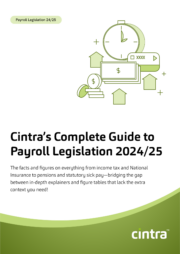From changes to tax rates and National Insurance to minimum wage and statutory payments, a new financial year always comes with new rates and figures for you to keep on top of.
And with the 2024 Spring Budget officially announced, now is the time to make sure you’re up to speed on what will be changing in payroll for 2024/25.
To make things easier for you, we’ve highlighted 5 of the key changes coming into force: tax rates, National Insurance, the national minimum wage and national living wage, statutory rates, and student loans!
Key payroll updates for 2024/25
Income tax
There are no changes to report across England, Wales, and Northern Ireland. The biggest changes to income tax for 2024/25 are happening in Scotland, including not only an increase to their top rate but a brand-new band also being introduced—the “advanced” band. Effective from 6 April 2024, income tax rates in Scotland for 2024/25 are:
| Band | Rate | Earnings |
|---|---|---|
| Starter | 19% | Up to £2,306 |
| Basic | 20% | From £2,307 to £13,991 |
| Intermediate | 21% | From £13,992 to £31,092 |
| Higher | 42% | From £31,093 to £62,430 |
| Advanced | 45% | From £62,431 to £125,140 |
| Top | 48% | Above £125,140 |
The shake-up means that tax rates will remain the same for most employees in Scotland, but higher earners will feel the impact of the higher top rate and the new advanced band.
Across the whole of the UK, the personal allowance remains frozen at £12,570, as it was in 2023/24. So, while those many employees in Scotland might not feel the impact of increased tax rates as the higher earners will, the entirety of the UK will be experiencing a ‘fiscal drag’ as wages rise with inflation, but the personal allowance remains the same.
For those not in the know: The House of Commons defines a fiscal drag as “Freezing tax thresholds increases people’s taxable income without nominal tax rates actually increasing. This results in additional revenue to the Government. This phenomenon is called ‘fiscal drag’, as more taxpayers are ‘dragged’ into paying more tax, or into paying at a higher rate.”
National Insurance
Likely one of the biggest announcements of this Spring Budget, and a welcomed change by many. The Chancellor confirmed that the National Insurance (NI) primary contribution will see a further cut to 8% on earnings between £12,570 and £50,270 from 6 April 2024.
This applies to employee contributions only. Off the back of a reduction to 10% early January 2024, the new rate sees majority of UK workers with an extra 4% back in their pockets than what they started the previous tax year with, when they were paying 12%.
NI thresholds and primary contribution rates for 2024/25 are:
| Thresholds | Weekly | Monthly | Annual |
|---|---|---|---|
| Lower Earnings Limit (LEL) | £123 | £533 | £6,396 |
| Primary Threshold (PT) | £242 | £1,048 | £12,570 |
| Secondary Threshold (ST) | £175 | £758 | £9,100 |
| Upper Secondary Threshold, Under 21 (UST) | £967 | £4,189 | £50,270 |
| Upper Earnings Limit (UEL) | £967 | £4,189 | £50,270 |
| Apprentice Upper Secondary Threshold (AUST) | £967 | £4,189 | £50,270 |
| Veterans Upper Secondary Threshold (VUST) | £967 | £4,189 | £50,270 |
| Freeport Upper Secondary Threshold (FUST) | £481 | £2,083 | £25,000 |
| Investment Zone Upper Secondary Threshold (IVUST) (new!) | £481 | £2,083 | £25,000 |
| Category letter | LEL to PT | PT to UEL | Above EUL |
|---|---|---|---|
| A, F, H, M, N, V | 0% | 8% | 2% |
| D, J, L, Z | 0% | 2% | 2% |
| B, E, I | 0% | 1.85% | 2% |
| C, K, S | nil | nil | nil |
Get the latest insights and best practice guides, direct to your inbox.
Minimum wage
There’s good news for minimum wage this year that means many people will see a boost to their income (and thanks to that, not so positively, their income tax—see ‘fiscal drag’ discussed under income tax changes!).
The biggest change is to the national living wage, which now applies to those aged 21 and over—as opposed to those aged 23 and over in previous years. While this is great for earners on the national minimum wage, you have to stay vigilant. Make sure to check your employees’ wages against schemes such as salary sacrifice which could see cash wages dip below the new limits.
The following national living wage and national minimum wage rates apply from 1 April 2024:
| Rate | From 1 April 2024 |
|---|---|
| Aged 21 and above (national living wage) | £11.44 |
| Aged 18 to 20 inclusive | £8.60 |
| Aged under 18 (but above compulsory school leaving age) | £6.40 |
| Apprentices aged under 19 | £6.40 |
| Apprentices aged 19 and over, but in first year of apprenticeship | £6.40 |
Statutory rates
‘SXPs’ are also seeing a small boost for 2024/25, covering all types of parental pay and sick pay.
A new parental pay rate of £184.03 (up from £172.48), from 7 April 2024, applies to:
- Statutory Maternity Pay (SMP)
- Statutory Adoption Pay (SAP)
- Statutory Paternity Pay (SPP)
- Statutory Shared Parental Pay (ShPP)
- Statutory Parental Bereavement Pay (SPBP)
The statutory sick pay rate is also set to increase to £116.75 per week (up from £109.40) from 6 April 2024.
The minimum average weekly earnings (AWE) remains at £123.
Student loans
Those on plan 1 will see a little extra in their pockets this year as the repayment threshold has risen to £24,990. The same goes to those on plan 4, with a threshold rise to £31,395. Those on plan 2 and postgraduate loans aren’t so fortunate, with their thresholds remaining frozen—the fiscal drag of student loans.
Rates and thresholds for student loan repayments for 2024/25 are as follows:
| Plan | Annual threshold | Rate |
|---|---|---|
| Plan 1 | £24,990 | 9% |
| Plan 2 | £27,295 | 9% |
| Plan 4 | £31,395 | 9% |
| Postgraduate | £21,000 | 6% |
The threshold for plan 2 and postgraduate loans is set to remain frozen until 2025, so we may see some changes coming in 2025/26.
Tax admin and maintenance day
And last, but certainly not least, the Spring Budget 2024 also confirmed that the government will make additional tax administration and maintenance announcements at the next Tax Administration and Maintenance Day (TAMB) on 18 April 2024.
It’s likely that new consultations will be published then, filling in the gaps from any measures missing from the Spring Budget. It’s also expected that they’ll advise on the actions they intend to take to tackle the tax gap and modernise the UK tax system—so as the saying goes, ‘hold onto your hats’, and hope for positive news.

Payroll Legislation Guide
The facts, figures, thresholds and allowances for 2024/25 spanning tax, National Insurance, pensions, statutory payments and more.
Download now
Let us help you with those changes...
Here at Cintra we’ve put in the time and effort to create a highly evolved, compliant and connected suite of software and services that means you don’t have to do all your payroll alone.
If you want the payroll software to do the hard work for you, Cintra Pay comes with all the statutory rates and thresholds you need included as standard.
Or if you prefer outsourced payroll, our CIPP-qualified experts become a true extension of your team and deliver the hard work for you.
Whichever you prefer, we’ll find you a payroll solution where you’re running even the most complex payrolls with speed, accuracy, and compliance.


